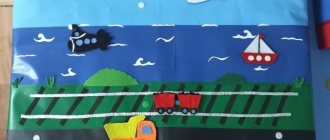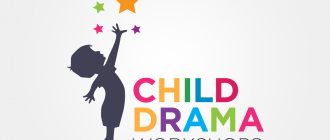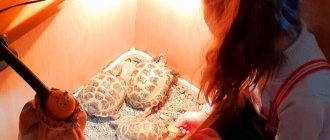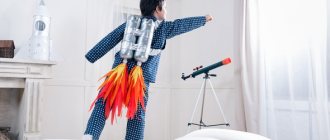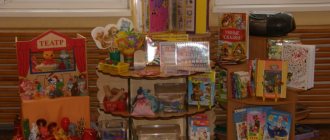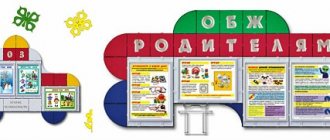An important part of the subject-development environment in the group room is the book corner. This thematic “center of the book” can play a significant role in shaping children’s sustained interest in books, the desire to read, and the need to learn new things.
In the publications presented in this section, teachers share their positive experience of creating beautiful, well-designed and functional book corners, and give useful advice on the aesthetic design of this part of the group’s subject-development environment.
Make the book corner the pride of your group!
Contained in sections:
- Book. All materials on the topic of books 6806
- Corners and centers in groups 6028
Showing publications 1-10 of 254. All sections | Book corner, center. Design examples
New
Photo
The best
Organization of a book corner in the first junior mixed age group
Reading fiction plays an important role in the development of children's cognitive and creative abilities. The main task of introducing preschool children to fiction is to cultivate interest and love for books, the desire to communicate with it, the ability...
Our book corner. Photo report
A book corner is a necessary element of a developing subject environment in a group room of a preschool institution. This is a form of disseminating information about books, their authors and illustrators, helping children get used to the image of a book, arousing interest in it, desire...
Everything for a child's development
Instill a love of books from childhood. Reading, especially paper books, develops imagination and creativity. The task of parents is to create a comfortable reading area for the child, where it will be pleasant to sit down with his mother or alone with his favorite book. Setting up a reading corner at home is easy. You can place it in the children's room or in the common living room where the whole family gathers. Just add a bookcase, armchair or cushion for comfort.
How to organize a reading area
- The place for reading books should be well lit. If there is not enough natural light, install additional lighting fixtures (chandeliers for children's rooms from Aliexpress).
- Make the corner multifunctional so that children can not only read but also play there.
- Make the area fun and attractive for the child with the help of bright colors, unusual decor depicting favorite book characters, and inspiring inscriptions (Aliexpress).
- If you organize a reading corner in a room where the whole family gathers, then it will be used more often.
- Place children's books where they are visible and accessible to the child.
Ideas for decorating a reading corner
Check out the ideas and get inspired to create the perfect book reading nook for your kids' room or living room.
Place pillows or a bean bag chair (Aliexpress) on the floor and your cozy reading corner is ready!
Children love decorative pillows, especially fluffy ones (Aliexpress).
Organize proper storage of books. All books should be visible and the child could get them on his own. For example, using shelves from Aliexpress.
Decorate your reading corner with children's posters (Aliexpress)
Hang a canopy over the chair (Aliexpress) and you will have an ideal area for privacy with your favorite book.
The reading area can be arranged directly on the floor by laying down a warm rug (Aiexpress).
An excellent solution for a reading corner would be a wigwam tent (Aliexpress).
Organize a reading space in your closet or pantry.
WE RECOMMEND: Place the mattress and pillows (Aliexpress) on the rack to create a comfortable place for reading.
If you are the happy owner of wide window sills, then you can arrange a reading corner there.
Use curtains (Aliexpress) to create a secluded place for reading books.
Organize a reading space under the stairs.
A toy house can serve as a place for privacy.
Use the area under the loft bed.
For the more adventurous, create a reading area at the top of the room.
What if there are two children and each wants their own reading corner? There is a solution!
In the summer, organize a reading place outside the city in nature.
Non-standard solutions. Reading books in a hammock (Aliexpress).
WE RECOMMEND ON LABYRINTH.RU:
SIMILAR ARTICLES:
Book corner, center. Design examples - Book corner in an early age group
Publication “Book Corner in the Early Childhood Group...”
In the Rainbow early childhood group, we have created a book corner in which children can independently choose books and calmly look at them. The book corner turned out to be cozy and attractive. It is located away from where children play, so that noisy games do not distract the child, good…
Image library "MAAM-pictures"
Basic requirements for the design of book corners
Fiction reveals to the child the main secret of life - he is not alone in this world: what worries him, cared for his ancestors, worries his contemporaries, will care for his children and grandchildren. A book corner is a necessary element of a developing subject environment in a group...
Group book corner
“Book corner of the “Romashka” group” V. Sukhomlinsky said: “Reading in childhood is primarily the education of the heart, the touch of human nobility to the innermost corners of a child’s soul.” Preschool childhood is a very important stage in raising an attentive, sensitive reader...
Book corner in the first junior group
A fairy tale is an amazing means of working with the inner world of a person, be it a child or an adult, a powerful tool for development and gaining experience. A fairy tale can help a child get to know the world and understand his own experiences. For a long time, everyday experience has been transmitted through figurative...
Design project of a subject-development environment in the group “Literary Reading Center”
Dear friends, we are pleased to introduce you to Svetlana Fedorovna Shabalova, a teacher of the highest qualification category at the joint venture “Kindergarten “Alyonushka””, State Budgetary Educational Institution Secondary School No. 2 named after. V. Maskina railway Art. Klyavlino, Samara region. Today Svetlana Fedorovna will kindly share her methods of creating pedagogical conditions for nurturing an interest in reading in preschoolers. The article will be of interest to teachers and interested parents.
A short commentary on the article from Svetlana Fedorovna:
“It is necessary to pay as much attention as possible to the development of the child’s inner world. Communication with a book provides invaluable assistance in this. Through reading fiction, a child learns the past, present and future of the world, learns to analyze, and develops moral and cultural values.”
Useful reading...
Design project of a subject-development environment in the group “Literary Reading Center”
View article in full version
Preschool childhood as a period in human life plays an important role in shaping what not only each individual person will become, but also all of humanity and the world as a whole. The educational, ideological, moral, and cultural priorities laid down in preschool childhood determine the life path of generations and influence the development and state of the entire civilization.
It is necessary to pay as much attention as possible to the development of the child’s inner world. Communication with a book provides invaluable assistance in this. Through reading fiction, a child learns the past, present and future of the world, learns to analyze, and develops moral and cultural values.
It's no secret that modern children spend more and more time playing computer games and watching TV. Sociological research in our country and abroad has revealed negative trends: interest in reading among younger preschoolers and adolescents is noticeably reduced; The share of reading in children's free time has been sharply reduced.
Today, the relevance of solving this problem is obvious. To raise a reader in a child, adults (teachers and parents) must themselves show an interest in the book, understand its role in a person’s life, know the books recommended for preschool children, be able to have an interesting conversation with kids and help in analyzing the work.
In kindergarten, work on the implementation of the educational area “Reading fiction” occurs both in specially organized activities and in the free independent activity of children. Opportunities to increase the effectiveness of this work increase provided that a subject-development environment is created in the group.
Scientists have proven that such factors in creating a situation of success and emotional well-being as design and ergonomics in the educational space of a group have a beneficial effect on the upbringing and education, as well as on the health of children, which is especially important when working with children with disabilities.
Today, to introduce children to reading fiction, each group of any kindergarten has a book corner or center. He was also in our group for children with visual impairments. But does its content comply with methodological and pedagogical requirements in the light of new regulatory documents? How can we make this center truly interesting and useful for children, so that books are present in various areas of a child’s activity, and children have the opportunity to interact with books every day and develop their literary interests? How to involve the children themselves and their parents to participate in the transformation of our book center?
These reflections gave us the idea of conducting an educational project in the group to transform and enrich the book center. This is how our design project “Literary Reading Center” was born.
The implementation of this project was also facilitated by the fact that, as part of Book Week, a competition between groups was announced at our preschool educational institution - “A Home for Our Favorite Books.”
Type of project: medium-term (3 weeks), informational and creative, group, open.
Project participants: group teachers, older children with visual impairments, parents.
Project goals:
- nurturing interest and love for books in preschoolers, developing cognitive activity and creative abilities of children in the process of transforming the “Literary Reading Center”;
Tasks:
- creating a subject-development environment in the group that promotes the development of preschoolers’ interest in reading, the development of cognitive activity, the creative abilities of children, as well as the interaction of all participants in the educational process;
- developing in preschoolers a sustainable interest and love for books and reading;
- development of creative abilities of children and adults in the process of transforming the subject-development environment.
Project resource support:
informational—formation of a database on project implementation; monitoring materials; organizing events to inform the public about the progress of the project;
methodological - development, preparation of plans, notes, presentations, recommendations for parents, memos, articles, etc.;
logistical - acquisition of didactic teaching aids: books according to the age program, illustrations, games, literacy aids, reading stands, etc.
equipping the Literary Reading Center with the necessary ergonomic furniture, shelves, desks, and additional light sources.
Expected results of the project:
for children – activation of cognitive and creative activity, disclosure of personal potential in the educational environment of the group and in the family,
for teachers - increasing the efficiency of work in the implementation of the educational field “Reading fiction”, the implementation of the personal and professional level of teachers, positive transformations of the subject-development environment of the group.
for parents - improving the pedagogical culture of parents, increasing the participation of parents in the life of the group and in educational activities.
The project was implemented in three stages.
Stage I – introductory stage of the project
Tasks:
- Inform all project participants of the importance of this problem. Get each participant (children, parents) interested in the topic of the project.
- Teachers determine the topic, goals and objectives, content of the group project, predict the result.
- Joint development of a work plan for the project; development of a model of interaction between all project participants.
- Selection and acquisition of methodological, popular science and fiction literature, illustrative, demonstrative, didactic and other materials on this topic.
- Discussion with parents of the project, clarification of the possibilities, funds necessary for the implementation of the project, determination of the content of the activities of all project participants.
When developing the project, we used the “three questions” model, traditional for project activities: “What do we know?”, “What do we want to know?”, “How to find out?”.
During the general discussion, we found out the children’s knowledge about books, why they are needed, where they can be purchased, etc. The children’s answers were recorded. The “Three Questions” model helped to draw up a specific action plan.
Additionally, we conducted a survey of children on the topic “Your favorite book.” The survey data showed that our children equally like folklore works and scientific literature - 35% each. The information obtained from the survey was useful to us in the process of compiling libraries and consultations for parents.
Stage II – productive stage of project implementation
The project is a product of cooperation and co-creation, therefore, whenever possible, we involved the parents of our students and colleagues.
The implementation of the draft plan planned at the first stage passed through all educational areas.
Tasks:
- Development of cognitive, communicative, creative abilities of children, taking into account their individual and age characteristics.
- Formation of an emotional, aesthetic and caring attitude towards books in children.
- Increasing children's interest in children's literature, teaching how to make a book.
- Updating and enriching the subject-development environment at the Literary Reading Center.
- Involving parents in the implementation of a common interesting activity, full communication with project participants.
Involving narrow specialists in the project (speech therapist, arts teacher, music director)
Contents of educational work with children during the project implementation:
Cognitive and speech development
Cognition:
Conversations with children: “How did the book appear?”, “What books do you love most?”, “What kinds of books are there?” etc.
Educational lesson using a multimedia presentation “The history of the creation of the book”
Excursions to the children's library named after. P.P. Bazhova
Lesson-travel “In the land of books” (presentation-introduction to the work of children's writer S.Ya. Marshak)
Looking at different types of books, illustrations in books, photographs,
Acquaintance with children's writers, literary genres in the process of compiling a catalog of books in the group library, classifying them into sections.
Reading fiction:
Reading works, memorizing poems, proverbs about the book
Quiz games using ICT based on the works of children's writers “In the Country of Chukovsky”, “Do you Know Fairy Tales?” and etc.
Children's book publishing
Communication:
“Favorite Book Day” - presentation of books based on writing creative stories (homework).
Compiling descriptive stories about the exhibits of the Museum of Books.
Social and personal development
Socialization:
Conversations about caring for books, rules of behavior in the reading room, library
Role-playing games “Library”, “In the reading room”, “Little guides (at the Book Museum)”, “Bookstore”
Work:
“Book Workshop” - manual labor for repairing old and torn books
Making little books for the children’s game “Library”,
Making bookmarks for your favorite book.
Safety:
Conversations about the rules of reading, about the dangers of reading while lying down, in the dark, about the correct posture when reading for good posture.
Physical development
Physical culture, Health:
Conducting visual gymnastics and dynamic pauses to train visual functions, increase visual acuity, and prevent eye fatigue
Artistic and aesthetic development
Artistic creativity:
Participation in the collection of exhibits and design of the Book Museum,
Design of a homemade book “Multi-colored book” according to S. Marshak
Drawing illustrations based on the works of S. Marshak, creating models and crafts together with parents for the exhibition “In the Country of Chukovsky”
Music:
Theatrical performance “In the Country of Chukovsky”
Description of the “Literary Reading Center”
To create a book center in our group, we set aside a place well lit with natural light. The book center is located in a group, it is located far from the play area. The Center has a selection of fiction that matches the program and age characteristics of children. There are also board and educational games based on familiar works. There is a folder where books and illustrations on the topic studied for a month are presented, as well as algorithms for composing stories. This folder is freely available to every child. A place has been allocated for games to teach literacy: it contains letters, diagrams, magnetic boards, material for teaching reading, books in the series “Read by ourselves”, “Read by syllables”.
There are theatrical attributes and attributes for role-playing games of the corresponding theme: “Reading Room”, “Book Store”, “Book Workshop”.
We also organized a thematic exhibition at the book center based on the works of S.Ya. Marshak:
- books, portrait of the writer, quotes, poems,
- toys, models for playing out episodes and memorizing the author’s texts,
- notes of classes, quizzes, leisure activities.
- As a continuation of the book center, it is planned to equip a corner of solitude, where a child can, in accordance with his interests, leaf through magazines, look at his favorite books, and also play out episodes of his favorite works using a toy theater, etc., and “call” his parents on the phone.
- It is also planned to design a display stand for an interesting book.
Our students often bring their favorite books to the group, including those of an educational nature, which orient them to study the world around them, giving them the opportunity to acquire new knowledge. We place such books in a specially designated place in a bright tray to attract children's attention.
At the book center, children have the opportunity not only to get acquainted with books, but also to assemble puzzles and cubes based on well-known and familiar literary works.
Design project element
"Mini Book Museum"
In the process of implementing the main design project, we organized another small project, including it as an integral element in the main project. They called it “Mini Book Museum”. The idea was suggested by the children themselves, asking the question: where can one see old books besides the library?
Goals and objectives of organizing a mini-museum:
introducing children to the history of books, cultivating an interest in reading, expanding knowledge about the role of books in human life, about different writers, about how literacy appeared and developed.
Location. Occupies part of the book center; exhibits are also placed on hanging wall shelves and a table.
The mini-museum contains ancient publications preserved in families, pop-up books, sound books, music books, etc.
Separately highlighted are works about nature, books for boys and books for girls, unusual books (little books, giant books, box books, books in different languages). Here you can also get acquainted with portraits of famous writers of the 19th and 20th centuries: A. Pushkin, L. Tolstoy, A. Barto, B. Zakhoder and others.
Of particular interest to preschoolers was the creation of an exhibition that contains models and samples of the very first books - stone books, parchment, papyrus, birch bark letters, clay tablets, as well as the “tools of labor” of writers. Here we have collected not only goose feathers and inkwells. From home, the children brought souvenir pencils, pens, and felt-tip pens of unusual shapes and sizes. We also included plasticine and clay plates and wooden toothpicks in the exhibition to give children the opportunity to try to write something on them, as our ancestors once wrote.
Element of the design project - children's book publishing:
“The Many-Colored Book” by S. Marshak
Implementation plan:
- We get acquainted with the original book, look at it, read it, talk about what we read.
- Together we develop the layout of the book.
- We draw and design our own illustrations for the book together with the group’s teachers.
- We print the text for the illustration pages of the book, color the letters on the cover of the book.
- We get acquainted with different types of book bindings, choose possible binding options for our book.
- We stitch the book on a stitching machine.
- We are holding a presentation for middle school children and parents.
Stage III – the final stage of the project implementation
Tasks:
- Analysis of the results of the project implementation in the group, adjustment of content, summing up.
- Generalization of the work experience of group teachers.
- Preparation and presentation of the Literary Reading Center as part of the review-competition “A Home for Our Favorite Books.”
- Planning further actions for the next period.
- Encouraging active project participants among children and parents.
Project presentation forms:
Presentation of the Center for Literary Reading as part of the preschool educational institution review-competition (1st place)
Opening and presentation of the museum during teaching hour
Conducting excursions for children and teachers of other groups, parents
/A book of reviews has been created/
Holiday “In the Country of Chukovsky” for children and parents
Working on the project in a group contributed to:
- development of cognitive, creative abilities of children and parents in joint activities, achievement of high results in children’s mastery of knowledge in the educational areas “Reading fiction”, “Cognition”, “Communication” (which was confirmed by monitoring data)
- creating a positive emotional communication environment between children, parents and group teachers
- activation and enrichment of pedagogical knowledge about museum pedagogy and project activities of all participants
- Possible growth points:
- continuation of work to attract parents and students to the project activities of the preschool educational institution
- presentation of experience in project activities to the city teaching community.
